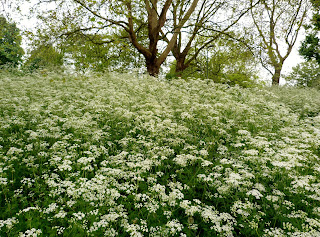Back home, a quick surf through Google proved that tail-less tits, though not common, are seen from time to time. The lack of a tail is usually the result of an accident or a predator attack. It doesn't seem to affect their ability to forage and frolic (like a "manic pom-pom" is how one tail-less tit is described) and the tail normally grows back after about four weeks. I haven't been able to photograph the Eastern Rd pom-pom, but here's a pic from the web::
 |
| From Asigaru's Nature Diary |
Sue and I saw four of those five key species during our May survey, the only absentee being the Mistle Thrush. There were plenty of birds singing, but the foliage is back on the trees and seeing the smaller birds is getting harder again. Our list for that day (of birds seen or heard) is as follows: Blackbird (6), Blackcap (1), Blue Tit (4), Crow (3), Chaffinch (1), Chiffchaff (1), Collared Dove (2 - an unusual sighting on Hilly Fields), Dunnock (1 - singing in the Vicars Hill border), Feral Pigeon, Goldfinch (3+), Great Spotted Woodpecker (1), Great Tit (4), House Sparrow (2), Jay (1), Long-tailed Tit (3), Magpie (2), Ring-necked Parakeet (1), Robin (5), Starling (6), Swift (2 - soaring overhead), Woodpigeon (3) and Wren (5+). 22 species - one of our best results. The Chiffchaff is only the second we've heard on Hilly Fields since their arrival in the UK in late March/April. And it occurred to me that the Jay would be able to hide itself better in thick woodland or scrub without that bright blue wing patch which gave it away this time. Here's a photo of one I took a few days earlier on the open edge of Hilly Fields wood:
Around the park in general, spring has sprung with a vengeance after the extended midwinter cold. All of the trees are in leaf, the horse chestnuts have their creamy-white flowers, the May blossom has appeared on the hawthorns, there are daisies and bulbous buttercups and even the occasional bee or butterfly. And one particular plant - as you can't fail to have noticed if you've been there recently - is romping away:
Yes, you can hardly see the trees for the cow parsley.


